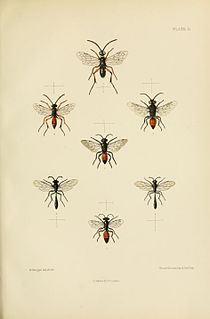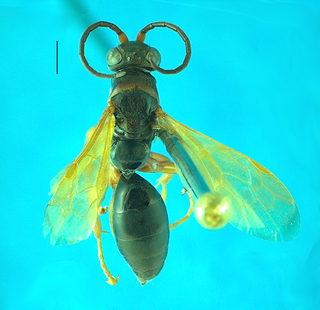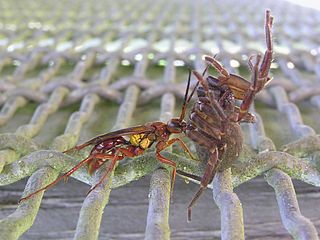
A tarantula hawk is a spider wasp (Pompilidae) that preys on tarantulas. Tarantula hawks belong to any of the many species in the genera Pepsis and Hemipepsis. They are one of the largest parasitoid wasps, using their sting to paralyze their prey before dragging it to a brood nest as living food; a single egg is laid on the prey, hatching to a larva which eats the still-living prey.

Wasps in the family Pompilidae are commonly called spider wasps, spider-hunting wasps, or pompilid wasps. The family is cosmopolitan, with some 5,000 species in six subfamilies. Nearly all species are solitary, and most capture and paralyze prey, though members of the subfamily Ceropalinae are kleptoparasites of other pompilids, or ectoparasitoids of living spiders.

Vespoidea is a superfamily of wasps in the order Hymenoptera, although older taxonomic schemes may vary in this categorization, particularly in whether to recognize the superfamilies Scolioidea or Formicoidea. Vespoidea includes wasps with a large variety of lifestyles: eusocial, social, and solitary habits, predators, scavengers, parasitoids, and some herbivores.

Pompilus is a genus of spider wasps in the family Pompilidae, the members of which prey on spiders. There are seven species recognised in Pompilus sensu stricto. It is the type genus of the family Pompilidae and the subfamily Pompilinae.

The Pepsinae are a subfamily of the spider wasp family, Pompilidae, including the tarantula hawks, as well as smaller species.

Dipogon variegatus is a pompilid spider wasp in the subfamily Pepsinae from the Palearctic.

Ceropales maculata is a kleptoparasitic spider wasp found in the holoarctic region.

Ceropales is a genus of kleptoparasitic spider wasps from the sub-family Ceropalinae of the family Pompilidae. They are characterised by the taking of the spider prey of other solitary wasps, mainly Pompilidae but members of the Sphecidae that provision with spider prey are sometimes also hosts. In some languages their name translates into English as "Cuckoo Spider Wasp".
The Ctenocerinae are a subfamily of spider wasps, Pompilidae, which contains a small number of genera, two in the Neotropics, four in Australia and the remainder in Africa. Ctenocerine wasps have evidently evolved from a common ancestor with the Pepsinae, but are specialized for preying upon trap-door spiders (Ctenizidae).

Epipompilus insularis is a species of spider wasp which is endemic to New Zealand and it is the only species of the genus Epipompilus found in New Zealand.

Sphictostethus nitidus, the golden hunter wasp or red spider wasp, is a species of pepsid spider wasp endemic to New Zealand.

Evagetes is a genus of spider wasps from the family Pompilidae. There are 72 described species, of which 58 are found in the Palaearctic region, 11 in the Nearctic region, with a few penetrating to the Afrotropical, Oriental and Neotropic regions. Evagetes wasps are kleptoparasitic on other pompilid wasps, especially the genera Arachnospila, Anoplius, Episyron and Pompilus, digging into their sealed burrows, eating the host egg and replacing it with an egg of its own. Evagetes wasps are characterised by their very short antennae. Most are species are black with the base of the antennae rufous, several Evagetes species are very metallic bluish insects.

Caliadurgus is a genus of spider wasps of the subfamily Pepsinae. These are medium-sized black spider wasps with some red. They have a catholic habitat choice and their preferred prey are spiders of the families Araneidae and Tetragnathidae. They have a Holarctic and Neotropical distribution.

Caliadurgus fasciatellus is a species of spider wasp from the subfamily Pepsinae found from Western Europe to the Far East of Asia.
Priochilus captivum is a species of neotropical spider wasp in the family Pompilidae. It is native to Central and South America. It was first described by the Danish zoologist Johan Christian Fabricius in 1804.
Anoplius infuscatus is a species of spider wasp found mainly in Eurasia.
Ireangelus is a genus of kleptoparasitic spider wasps from the sub-family Ceropalinae of the family Pompilidae. The genus has a pan tropical distribution, being known from Oriental, Neotropical, Australian, eastern Palearctic, and Madagascan Zoogeographic regions being best represented in the Neotropics. Irenangelus is closely related to the more widespread genus Ceropales, the two genera forming a monophyletic subfamily, Ceropalinae within the Pompilidae. This is regarded as the most basal grouping of the Pompilidae but this view is problematic because of the kleptoparasitic life history of the Ceropalines, it is now considered that they Ceropalines and other pompilids evolved from a common ectoparasitoid ancestor.

Tachypompilus analis, the red-tailed spider wasp is a species of spider wasp found in most of tropical and subtropical Asia, north to Japan. These spider wasps often hunt huntsman spiders.

Pepsis grossa is a very large species of pepsine spider wasp from the southern part of North America, south to northern South America. It preys on tarantula spiders, giving rise to the name tarantula hawk for the wasps in the genus Pepsis and the related Hemipepsis. Only the females hunt, so only they are capable of delivering a sting, which is considered the second most painful of any insect sting; scoring 4.0 on the Schmidt sting pain index compared to the bullet ant's 4.0+. It is the state insect of New Mexico. The colour morphs are the xanthic orange-winged form and the melanic black winged form. In northern South America, a third form, known as "lygamorphic", has a dark base to the wings which have dark amber median patches and a pale tip.

Allochares azureus is a species of spider wasp from the family Pompilidae, it is the only member of the monotypic genus Allochares. It occurs in the southern part of North America and is a specialist parasitoid of the Southern house spider.















